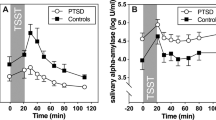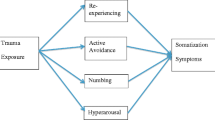Abstract
Comparisons were made between a group of male Vietnam veterans suffering from Post-Traumatic Stress Disorder (PTSD) (n=11) and an age and sex matched group of nonveteran controls (n=11) on their psychophysiological responding (heart rate (HR), blood pressure (BP), forehead EMG, skin resistance level, and peripheral temperature) to mental arithmetic and an audiotape of combat sounds played at gradually increasing volume levels. The two groups responded differently to the combat sounds in terms of HR, systolic BP, and forehead EMG. The HR response could correctly classify 95.5% of the combined sample. Implications of these findings for the basis of PTSD are discussed.
Similar content being viewed by others
References
Diagnostic and Statistical Manual of Mental Disorders, 3rd ed, (DSM-III), Washington, D.C., American Psychiatric Association, 1978.
Freud S:Forward in Psychoanalysis and the War Neurosis. New York, International Psychoanalytic Press, 1921.
Kardiner A: The traumatic neuroses of war.Psychosomat Med Mono 11: 111, 1941.
Van Putten TV, Emory WH: Traumatic neuroses in Vietnam returnees: A forgotten diagnosis?Arch Gen Psychiat 29: 695–698, 1973.
Figley CR:Stress Disorders Among Vietnam Veterans. New York, Brunner/Mazel, 1978.
Laufer CJ:Legacies of Vietnam: Comparative Adjustment of Veterans and Their Peers. New York, Center for Policy Research Inc., U.S. Government Printing Office, 97th Congress, First Session, House Committee Print #14, 1981.
Goldman P: What Vietnam did to us.Newsweek, December 14, 1981, pp. 46–97.
Gillespie RD:Psychological Effects of War on Citizen and Soldier. New York, W.W. Norton Co., 1942.
Dobbs D, Wilson WP: Observations on persistence of war neurosis. Dis Nerv Sys 21: 40–46, 1961.
Beck AT, Ward CH, Mendelsohn M, Mock J, Erbaugh J: An inventory for measuring depression.Arch Gen Psychiat 5: 561–571, 1961.
Spielberger CD, Gorsuch RL, Lushene RE:STAI Manual for the State-Trait Anxiety Inventory. Palo Alto, CA, Consulting Psychologist Press, 1970.
Buss AH, Durkee A: An inventory for assessing different kinds of hostility. Consult Psych 21: 243–248, 1957.
Nie N, Hull CH, Jenkins JG, Steinbrenner K, Bent DH:Statistical Package for the Social Sciences 2nd ed. New York, McGraw-Hill, 1975.
Kolb LC, Mutalipassi LR: A sub-class of the chronic and delayed post traumatic stress disorders: The conditional emotional response implications for research and treatment. Paper presented at 135th Annual Meeting, American Psychiatric Association, Toronto, Canada, 1982.
Author information
Authors and Affiliations
Rights and permissions
About this article
Cite this article
Blanchard, E.B., Kolb, L.C., Pallmeyer, T.P. et al. A psychophysiological study of Post Traumatic Stress Disorder in Vietnam veterans. Psych Quart 54, 220–229 (1982). https://doi.org/10.1007/BF01064817
Issue Date:
DOI: https://doi.org/10.1007/BF01064817




